Afloat – an essay
Afloat
by Meg Stainsby
*Dedicated to John Cau (ca. 1960 – 2020) – in memoriam
*

My home floats. It isn’t a boat—it doesn’t sail or chug along under the steam of an outboard—it’s a two-storey house with beige aluminum siding, rising off a 625 ft2 base, and it bobs in place where it’s moored fast to a dock in a North Vancouver marina. From my rooftop deck, I can see back across Burrard Inlet to Vancouver’s downtown skyline. If I were like the gulls hanging above me in the air, I could take in the city’s entire coastline. Vancouver’s serpentine seawall twists and turns from its head—right south of me in Coal Harbour—as it coils around Stanley Park, folds back under several bridges, turns south at Science World in False Creek and then snaps its tail westward along the south shore of the Creek to its west-most point on the shores of Kitsilano. Twenty-two kilometres of tamed urban shoreline, beaches abounding. Yet there are very few communities like mine, where people choose to drop anchor or tie up rather than mow the lawn.
An old friend pronounced to me that people who live in floathomes are quirky contradictions. They want the intimacy of the small town mixed with the liminality of an outskirt. It’s like you’re in a village without actually being anywhere, he said. You don’t really exist. You’re on the edge.
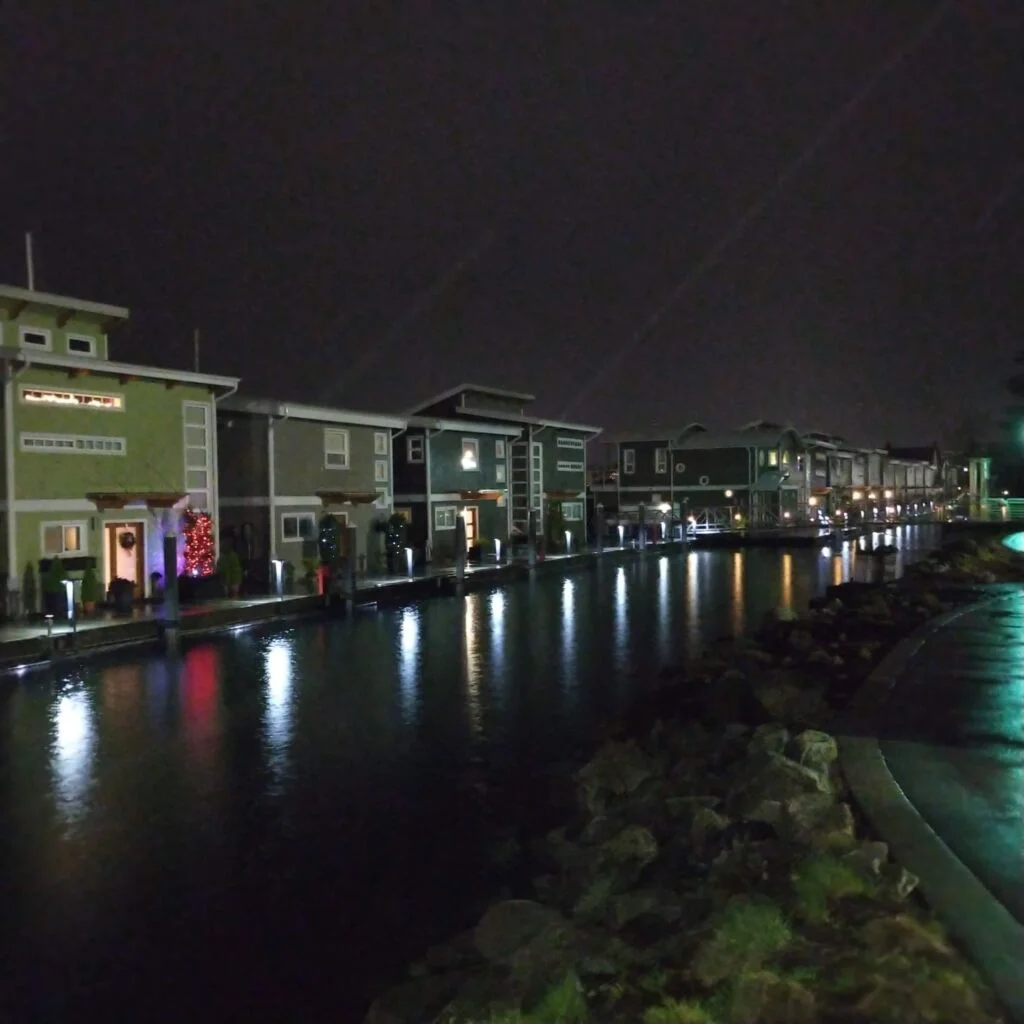
There are two floathome communities on City of Vancouver water. Six homes are scattered amongst the hundreds of yachts and sailboats moored in rich Coal Harbour; another dozen bob closely together in Sea Village, a co-op community tied up along one edge of Granville Island, in False Creek. For a city defined by its shoreline as much as by its mountains and known for its nature-loving counter-culture, Vancouver has surprisingly few official year-round water dwellers. Across Burrard Inlet, the smaller district of North Vancouver boasts as many marinas and a growing number of floathomes: Lynnwood, just west of the Second Narrows Bridge, and Mosquito Creek Marina, where I live, just west of Lonsdale Quay. Both marinas are First Nations territory, run by the local band, the Squamish, and both have been home to a small number of floathomes for decades. Tea-cup sized villages on the watery borders of an urban landscape.
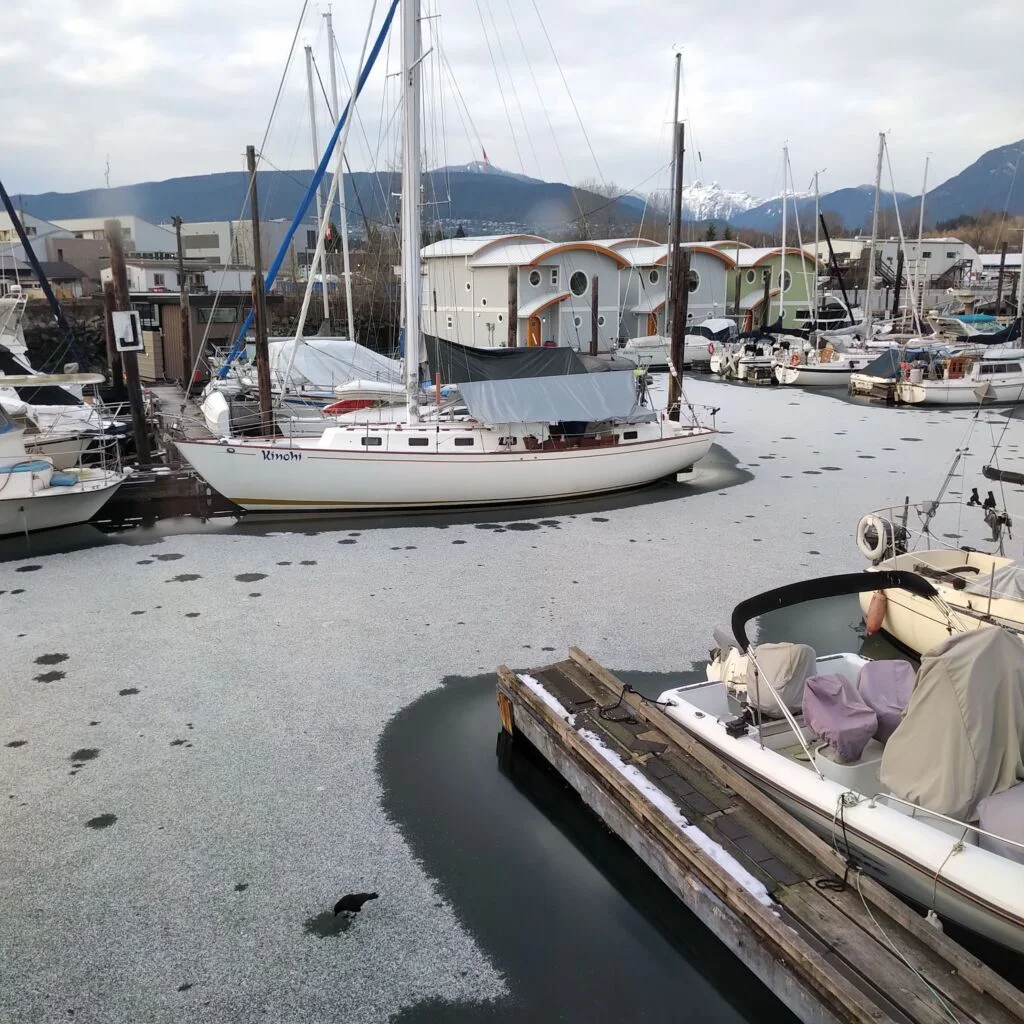
Tides rule the marina. High tide is when it’s easiest to manoeuvre carts laden with propane canisters and recycling bins up to the parking lot. Low tide is when the exposed muck stinks best, when a writer is glad for a language rich in words like bracken, fetid, jetsam, fecund, kelp.
The Squamish elder who appears just after first light most mornings has few teeth, but smiles as broadly as if she were showing off a perfect set. She lugs tools, bags, sometimes a crab trap, buckets. She dresses in layers, topped off by a fleece vest. Sometimes a younger woman comes with her—I imagine it’s her granddaughter—and they sit on folding canvas stools whipped out from somewhere. The first time I pass the elder on the ramp as I’m heading to work, I feel a flash of insecurity, wondering if she might challenge me for living on her land—or at least, for floating on its edge. But she just smiles, then calls out after me, I’m going for mussels! Yum! Just like that.
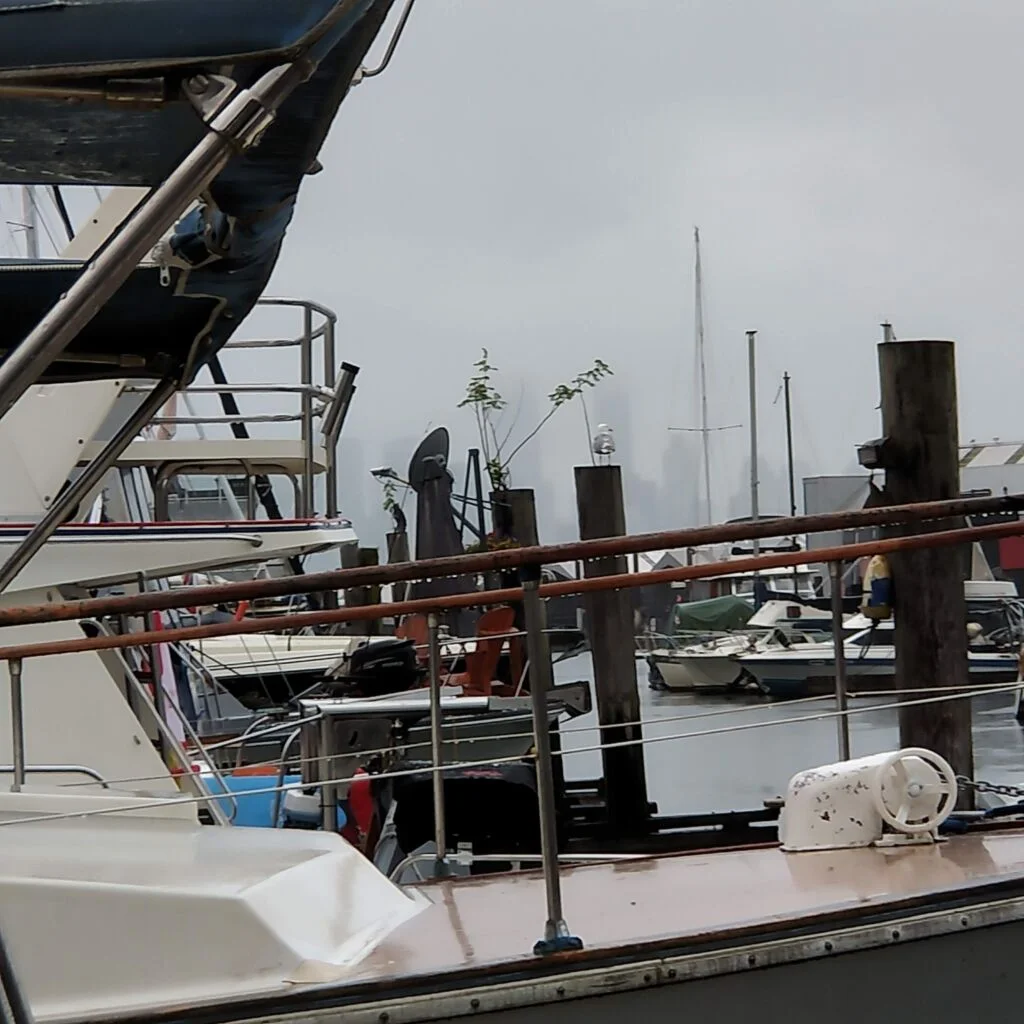
My marina neighbours, the men I refer to collectively as Dock Boys, waylaid a lover of mine one evening as he was heading down the dock, scrutinized him, he said (when he showed up, ten minutes late), handed him a beer, took the measure of how he drank. When he came inside he said, I’ve just been tested. Did you pass? I asked. They want to know, Why him? How come he spends the night? See, I said, the marina is a small town. I wonder what they say when the float starts to rock.
The marina has no sewer system. Household waste is pumped right into the sea. I’m shamed by the inevitable question about this—although not enough to move back to land. The realtor assured me that a sewage system will come. The impulse behind this is tied to expansion: new floathomes are being tugged in one by one. Over the past year, six have arrived—four occupied, two still in need of interior finishing. I’m keen for the sewage hook-up, as the staff must be. The marina employees are members of the Squamish Nation: it can’t look good for the Indigenous community to be profiting while we residents spew waste into the sea. The situation defies stereotypes. Yet, I tell myself, seals do it; otters do it; salmon, gulls and ducks do it. How much additional crap can these few humans produce? Why am I so shy about our shit? I am, though. And just as shy about admitting that I buy Seventh Generation cleaning products, some confused gesture towards commercially packaged First Nations eco-wisdom. Really, I should just scrub everything with baking soda and elbow grease. I do learn right away not to flush anything that I don’t think fish and seals would eat. I can be heard calling down the garburator some mornings, Do you like orange peels? Coffee grounds? An ecology can hardly be more intimate than this, floating above one’s hungry neighbours.
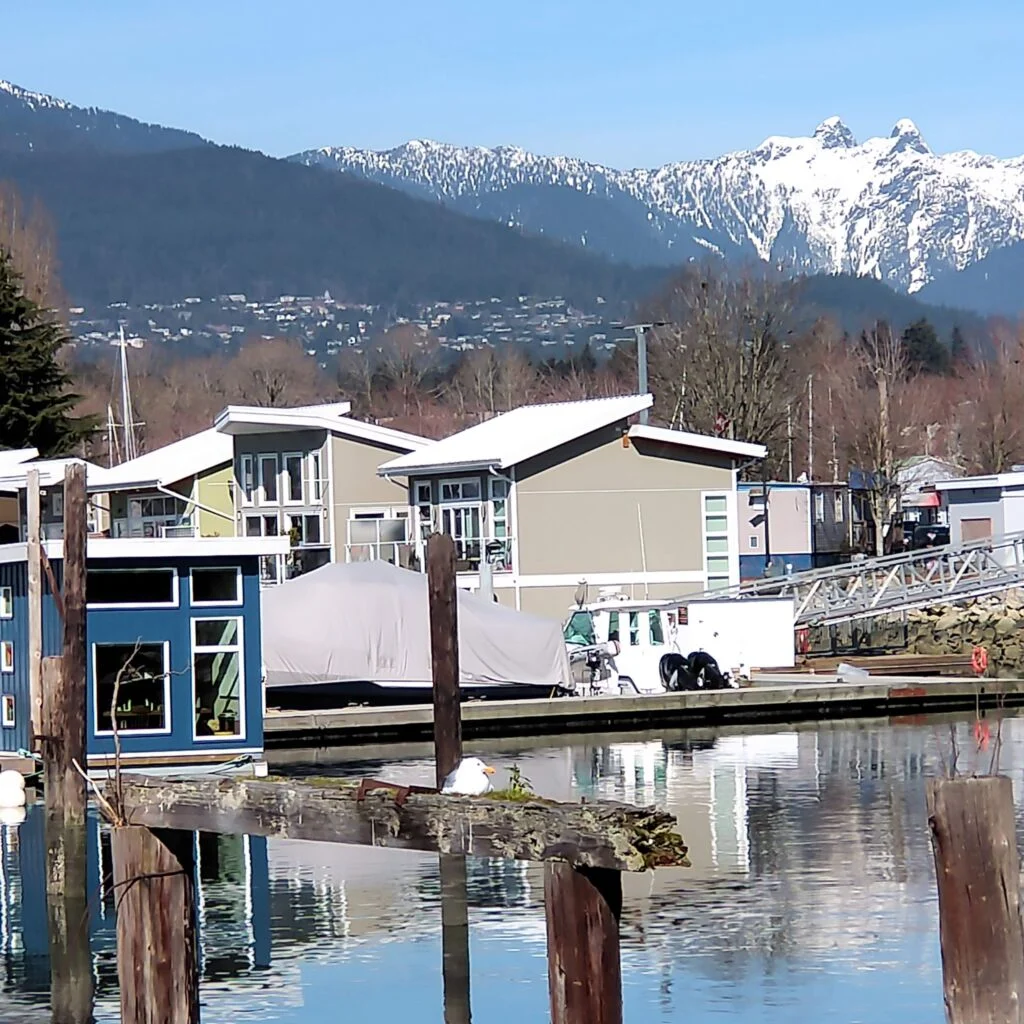
My friend David came with me to view this floathome when it was for sale. He pelted the realtor with questions about life in the harbour while I stood on the rooftop deck and looked up at the twin North Shore peaks I’ve grown up calling the Lions—which I’m learning now to call the Sisters, by their traditional Squamish name. David asked, What do they do about the rats here? The realtor looked startled. What rats?
I’ve lived at Vancouver marinas before, near the two docks where floathomes now bob on the civic sea, only I lived on boats then. In my final year of high school, before Coal Harbour was too costly for working folk, my fisherman brother Jon and his fisher-friends wintered over at the old wharf east of the Bayshore Hotel. I fell in love with one of those friends—Richard—and moved aboard The Seafarer, his thirty-eight foot trawler, late that autumn. In the new year, Richard gave up fishing, sold the trawler for an out-of-commission packer, an eighty-foot beast docked in Queensborough. We floated her up the Fraser River, around Point Grey and into the placid, pricey waters surrounding Granville Island. Using blowtorches, we stripped the hunter green-and-white trademark colours of the Nelson Brothers Packing Company from the old wooden boat, rubbed the cabin’s wood until it gleamed through layers of deep stain. Then Richard did the unthinkable and re-named her: she was bought as The Western Princess and became Clayquot II. Years after he grew bored with me, Richard was murdered aboard that boat, while anchored in Hunt’s Inlet, shot by his own brother, another fisherman who’d spent too many summers at sea. I’ve been remembering Richard more often since moving to Mosquito Creek—more than thirty years later, floating in eyeshot of where I fell in love at seventeen, where I made love in the belly of The Seafarer. People go stir-crazy cramped too long in close quarters, some say. Back at sea myself, I wonder at the superstition against re-naming water vessels. I want to christen my floathome—I have a name picked out: The Pippin, a tribute to another dead friend, or at least to her cat—but I’m leery of calling down the wrath of the water gods by presuming to have such power.
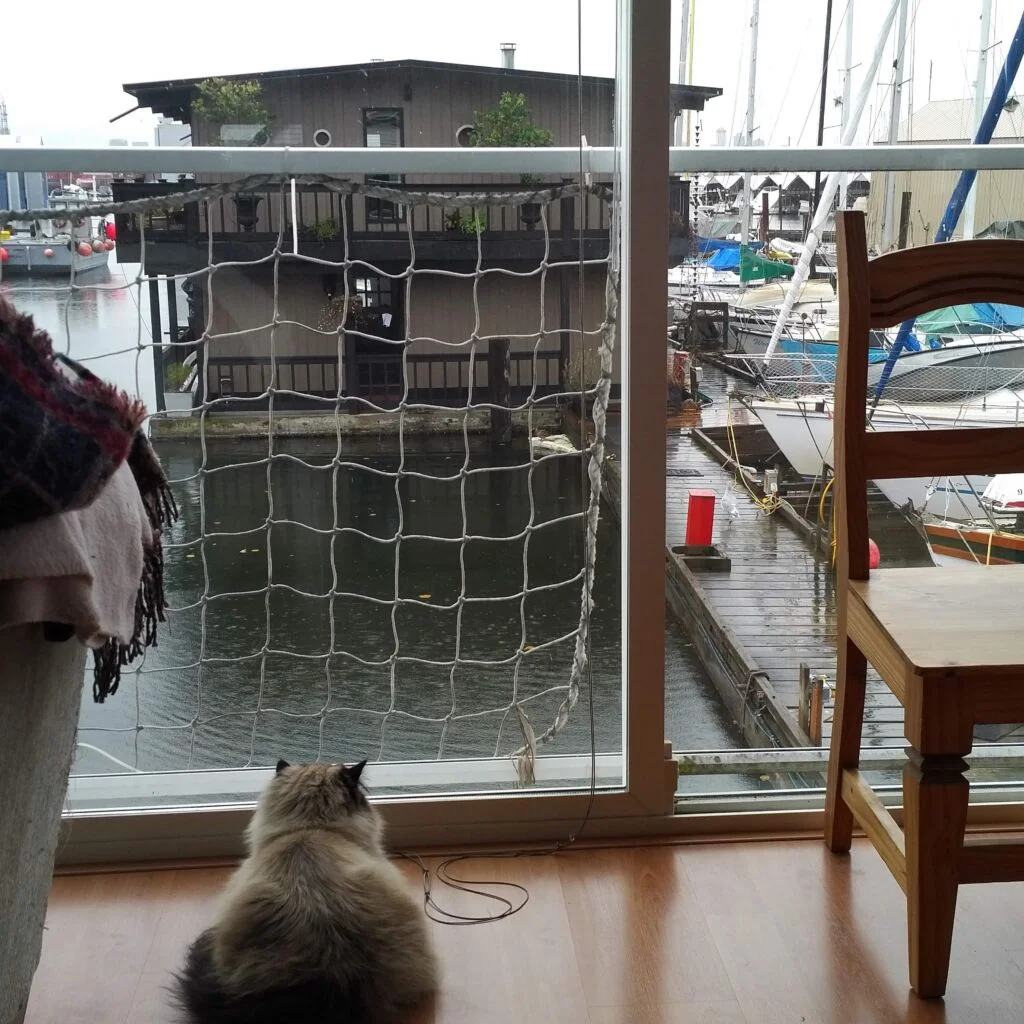
A great blue heron nests in an evergreen clinging to the shoreline beside the marina parking lot. The tree is a cedar, branches low as if it were weeping; it offers a close, hidden perch from which the heron spies the water’s edge. Sometimes the bird swoops past my window as I sit in the kitchen. I’ve heard it call—a guttural squawk very like the noise I imagine a pterodactyl would produce. There is only ever one heron. In the early winter months, it took to standing on the dock before dusk. One night, my daughter called to ask if herons were aggressive. It’s right in front of me, she whispered into her cell phone. Can I walk past? She laughed then as it flew up to the roof of the floathome moored at the corner of E dock, the one with the painted sign over its door that reads, The Blue Heron. The home is bluer than the bird, she giggled.

I timed my move to take advantage of high-tide, but the movers got lost. By midnight, as they stomped off, exhausted and soaked by rain, the tide had dropped three-quarters to low, and the ramp was nearing a 60° angle. I tell my friends I’ve got a built-in sobriety test now, and to wear sensible shoes when they visit.
My home is moored the furthest from shore, way at the end of E dock, so that gauntlet my lover once walked is one I face daily. Marina residents are amiable but reserved. We collude to pretend a greater distance separates us than is possible in this tightly-packed Lego-set of homes along a narrow floating sidewalk. One midsummer night, as I headed back towards shore, the Dock Boys hailed me. Red-eyed and stoned, beer in hand, John and Bill were peering over the edge into a pool of eerily lit water, the ring of light from the mechanic’s lamp they’d clamped onto a cleat. They were ooohing over a school of tiny, minnow-like fish drawn to the warmth of the bulb. Look at that! Jellyfish! Hey, want a beer? I stood, quiet in the dark fringe of their friendly ring, enjoying the light and dance. Just as I turned away, something black thrust up towards us — a seal busting into the centre of the swirling fish from under the dock. It nearly sent John right off his keel. Shit, man! Did you see that?
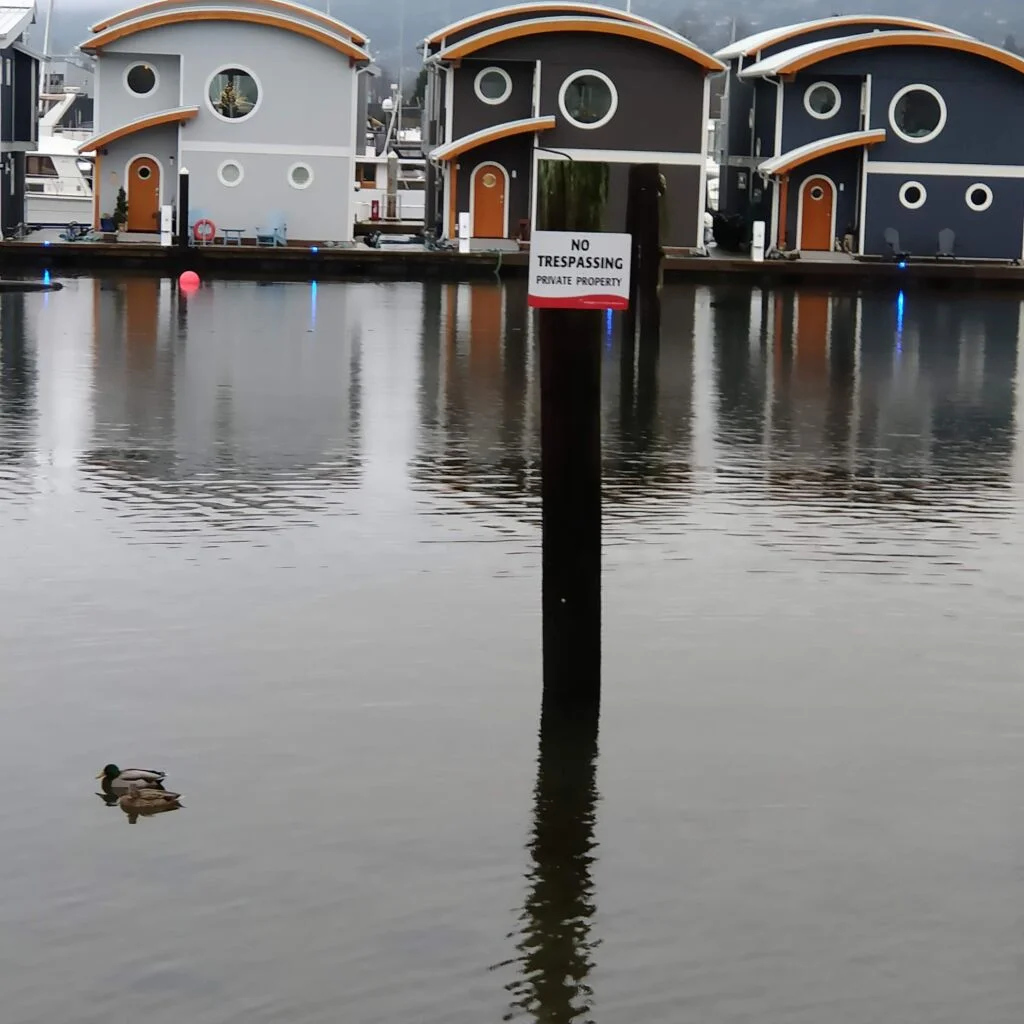
The harbour seals in the Vancouver waters, once culled to the point of scarcity by fishers protecting their stock, thrive again in this region. They habituate easily to humans, do well by edge-dwellers. When elders clean their fish after a day on the dock, they bang on a metal railing—just a few hollow knocks—and the seals swarm in, raising their heads, ready for offal.
A Freudian-inclined friend of mine, visiting the first time, listening to me crow on about my new life—in a floathome, in the harbour, on the city’s edge—emailed me the next day to declare that sleeping on the face of an inlet is like sloshing about in amniotic fluid all night. No wonder you love it, he wrote. Primal comfort—return to the womb, holy mother of everything. Huh, I typed back, and I’d just thought I was being, you know, edgy.
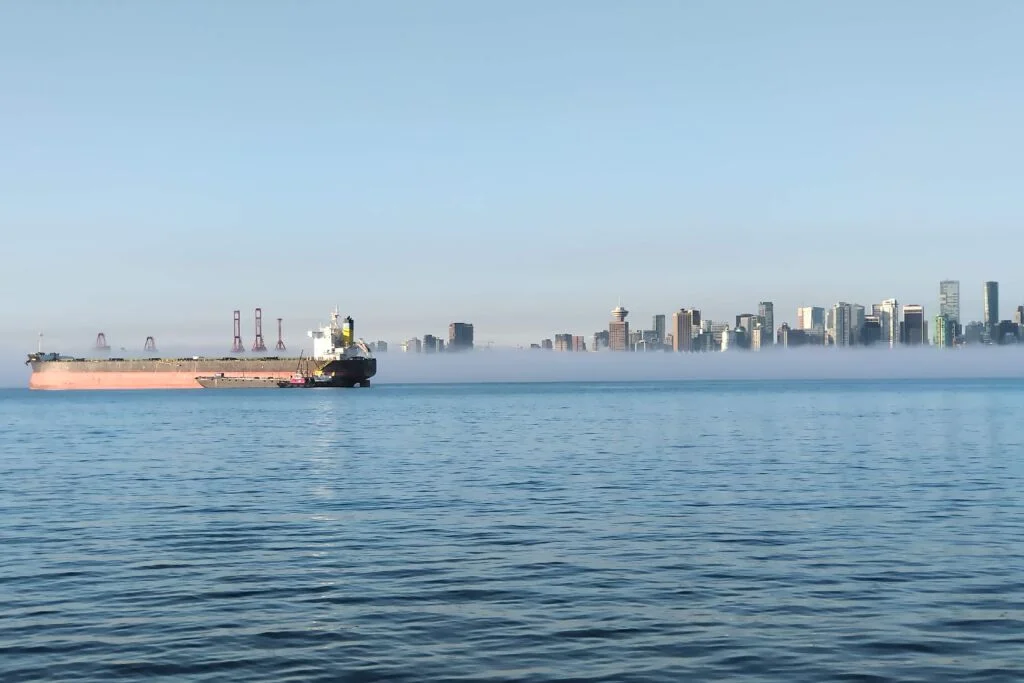
Our first summer here, a harbour seal whelped on the dock. My daughter and I, coming down the ramp in the mid-afternoon sun, stopped short when we saw the mother and pup ahead. They didn’t budge, and I joked that the momma seal looked stoned. It’s odd that she’s let us get so close, I said. A neighbour on D dock stuck her head out to say, The pup’s only fifteen minutes old. Ah, I said, Momma is stoned. Blissed out. Over the next several weeks we got to know this pair. We learned that seal pups have grey eyes like human pups have blue, that the eyes darken with the darkening coat, that seals often nurse their pups at low tide. A few times, children walking along the Spirit Trail above the rocky shore shrieked and pointed down at the pup alone on the sunny rocks. They cried out for their parents to rescue this babe, as if terrified by its solitude. It’s okay, I learned to say, Momma is just gone fishin’.
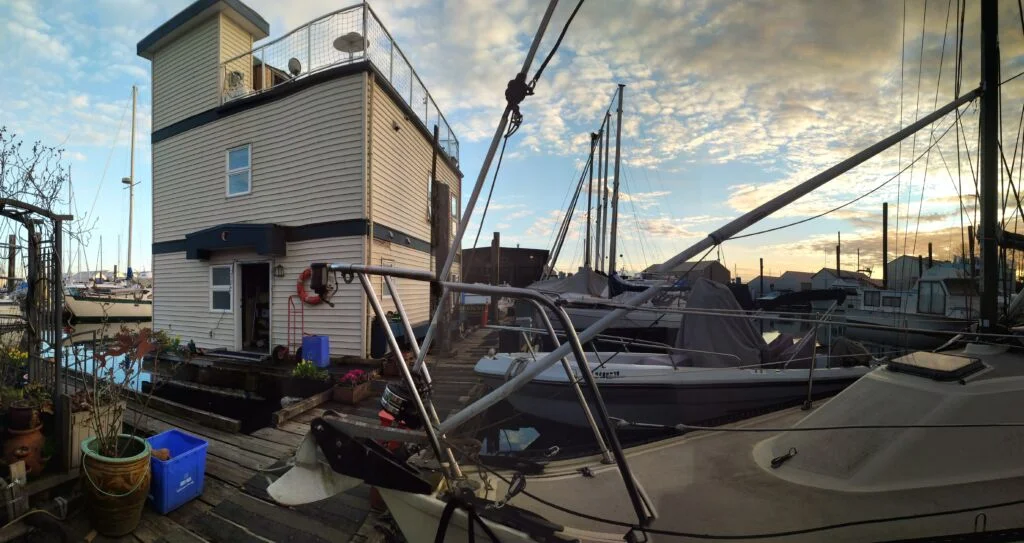
I haven’t ever seen a rat at the marina. Lots of skunks, though, and raccoons. And mink—a whole litter of mink were reared under a tarp on D dock late one summer. They raced and slipped and slithered around, playing tag one warm afternoon while I watched from my rooftop.
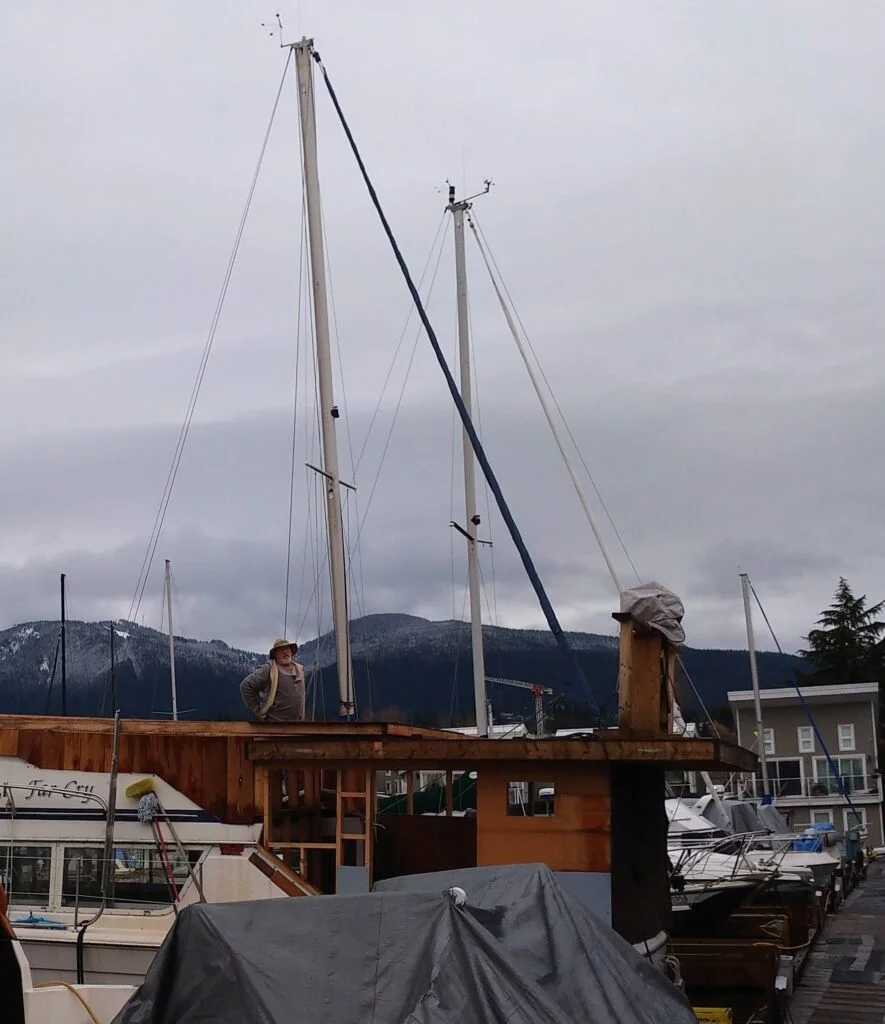
Even among the idiosyncrasies of marina life, John and his place are distinctive. John, whom I think of as chief Dock Boy, goes into the water on purpose on hot summer days. He lives in a Kelly-green shack thrown up over the pontoon-base of an old floatplane. The walls and windows are unmatched and off-kilter, scraps salvaged from movie sets where he works construction. Early ‘70s stoner rock and blues riffs drift out in the evening, riding on clouds of pot smoke. He has two cats, whom he introduced to me as Frick and Frack but who seem to have become Paco and Fuego recently. John takes them for daily walks to the far end of E dock, one at a time. He’s built a container garden of old vegetable crates and cracked pots lining the dock. These boast everything from chives, cherry tomatoes and strawberries to catnip for his furry boys. After heavy North Vancouver rains, the containers become so swollen that the dock tilts along the length of John’s home. To gauge the tide, I peer down towards the metallic Chinese dragon he’s nailed to a piling. When the dragon rides high in the sky, tide’s out and the ramp will be steep—not the time to lug my propane tanks up for refuelling. But when the dragon’s crouched low over the chives, I know I can walk straight off the dock onto level earth. Just like that.
At low tide, a small, mucky, crescent-shaped beach emerges from the sea east of A dock. The dogs that live on boats and floats, usually restricted to a leash and a seawall stroll, are granted this narrow curve of mud on which, briefly, to run.
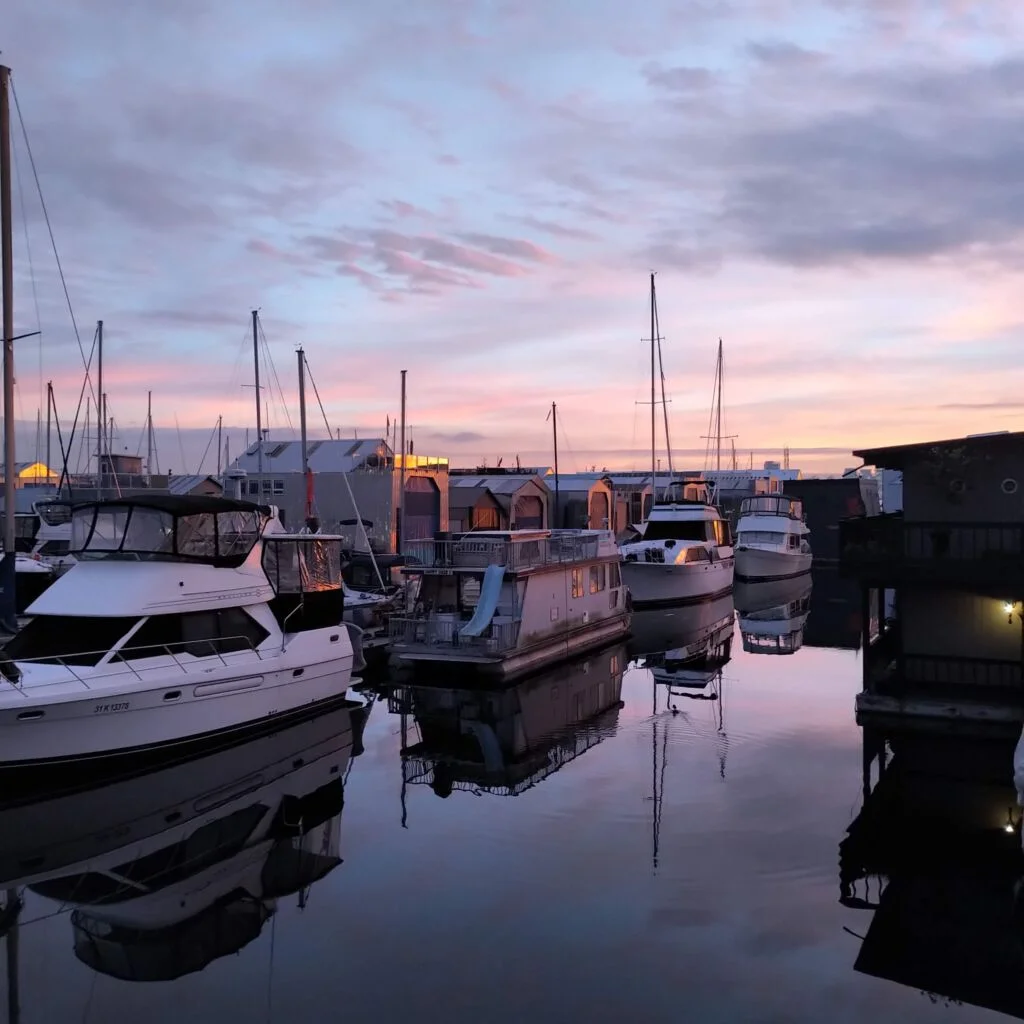
I had an impromptu supper party early last September with seven or eight friends. We’d been hiking in the Mount Seymour forest north of the inlet, and got caught in a downpour so fierce we were drenched to our underwear despite the canopy of cedars, both old growth and new. I invited everyone back to the float, and tossed out towels, robes and temporary clothes while people threw their soaking layers into the dryer. Hours later, after a hastily raised supper of deli food and wine, my friends dressed again in toasty fabrics and preparing to leave, someone called us to the front glass wall, looking south to the city skyline. On the dock below, something was moving—a shadow, a large dark creature that became an otter the size and colour of a black Lab. It threw itself down in the low beam of a footlight and was proceeding casually to crack open and slurp back its supper. We watched the otter gorging, entranced. When done, it dove off the dock, leaving behind remnants of the feast – broken bits of a large crab, legs and back torn asunder, every sinew sucked clean.
Diver Dan is a mostly-out-of-work actor who lives aboard a yellow sailboat at the marina. He’s also a licensed diver with suit and tanks. For two hundred dollars, he scrapes a year’s worth of mussels from the submerged perimeter of my floathome, and strips the moor lines of their mossy, slimy green. With an hour’s work, he pries loose enough mussels that my home bobs up, gaining an inch of freeboard. Dan’s offered me the mussels to eat, but I’m allergic to seafood.
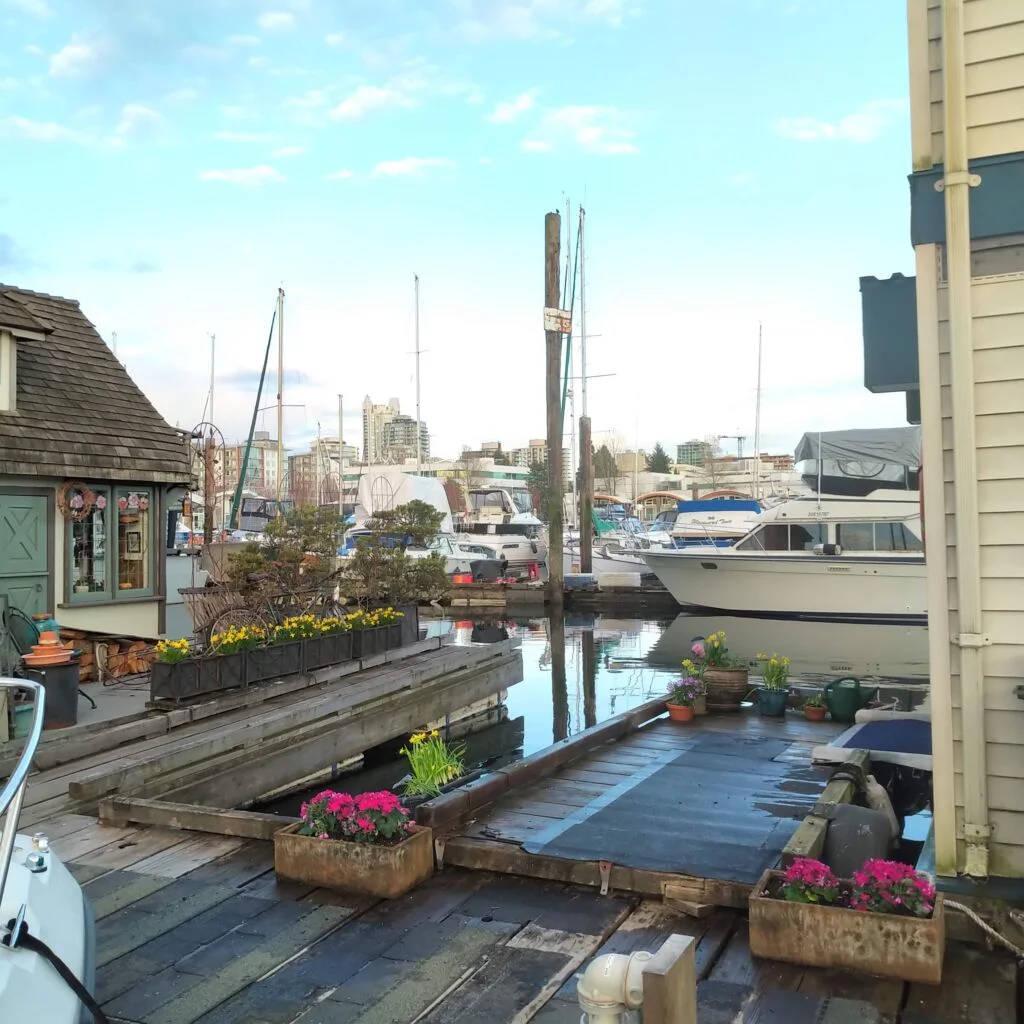
People fall off docks. They do. Just like that. It’s a law of the universe, one of the main differences between docks and seawalls. The day I first went in for an accidental swim, early one October, I noticed the lack of an exit—no dock ladders for floathomes, unlike boats. And the dock fingers crisscross in such a way that swimming to the rocks would, at the least, require a daringly deep dive under the main platform nearest shore. I paddled about in small, ever colder circles, noticing my muscles beginning to numb, while my friend shouted for help. Roused from his smoky hut, John pushed my friend aside, tore a ladder from the back of a neighbour’s boat, and yarded me up onto the dock by one arm as I began to climb. As soon as I’d showered and dressed, I walked to the Marine Store and bought my own ladder. The Dock Boys laughed as I passed them, carrying my prize home—the wrong sort of metal, it seems, to be left dangling in the sea. It’s gonna rust so fast! My marginally useful ladder hangs outside now from the life-saver on a hook on the siding, where—like the life-saver—it will be out of reach when I fall in again. I’ll have to put my faith in my neighbours.
In the marina, even the most solitary creature is never alone. I’m reminded of this as I sit working at the computer at the kitchen table, the sliding glass door that is my south wall opened fully to the sky, the air mild—slightly breezy, sleepy—punctuated now and then by the clanging of pulleys and winches against masts, the harbour’s answer to village bells, by the rising and falling words of boat owners drifting up and down the dock, and by the simple, piercing caw of forever-hungry gulls. I rise to lean out over the water in time to see, from behind the boatsheds furthest from shore, the nose of a ceremonial canoe appear. Sixteen youth are paddling together, heeding the downbeat of the drum. They are coming in at a fair clip, heading for shore, and I lean over the rails to look north, where they’re bound. On the cross-dock between C and D stands a young Squamish girl, maybe fourteen, her forearms raised skyward, palms turned to her face. She is gazing at the approaching canoe and smiling. She is welcoming them home.
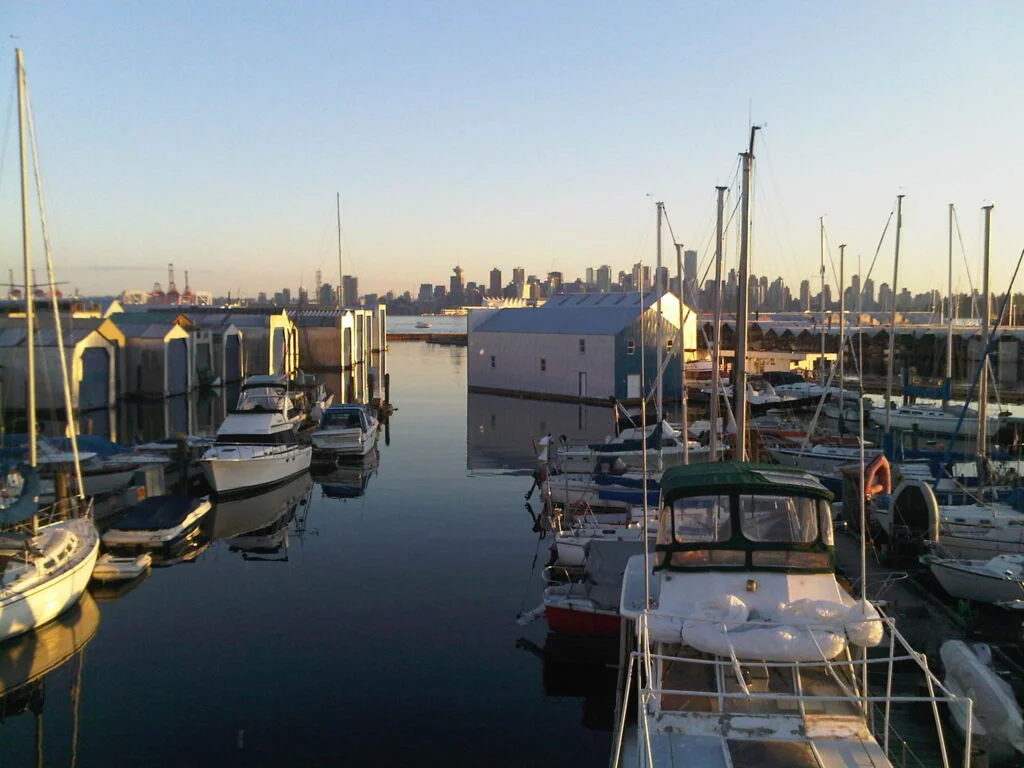
*
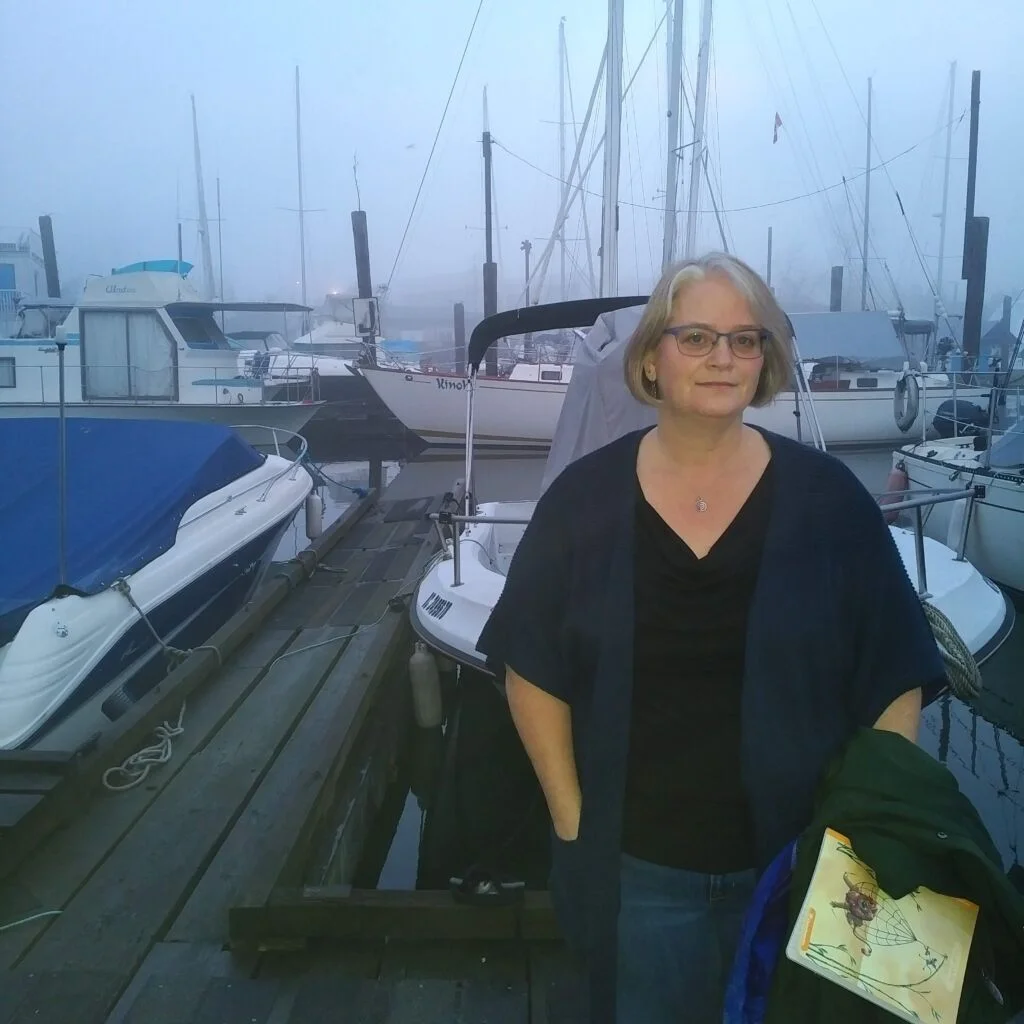
Meg Stainsby (GLS 2000 cohort) wrote “Afloat” in 2013, while living at the marina and completing an MFA in Creative Writing (UBC). She has since moved on, leaving Mosquito Creek Marina in 2019 and completing a PhD in Creative Writing (University of Wales Trinity Saint David, Wales) in 2022. Meg now splits her time (ragdoll cats in tow) between Vancouver and Salt Spring Island. [Editor’s note: Meg Stainsby has contributed previously to The Ormsby Review, The militant mothers of Raymur and Writing My Father (“Stainsby’s Carbons and Files”), a memoir of her father Don Stainsby (1928-1981), the well-known columnist for the Vancouver Sun.]
*
The British Columbia Review
Interim Editors, 2023-24: Trevor Marc Hughes (non-fiction), Brett Josef Grubisic (fiction)
Publisher: Richard Mackie
Formerly The Ormsby Review, The British Columbia Review is an on-line book review and journal service for BC writers and readers. The Advisory Board now consists of Jean Barman, Wade Davis, Robin Fisher, Barry Gough, Hugh Johnston, Kathy Mezei, Patricia Roy, Maria Tippett, and Graeme Wynn. Provincial Government Patron (since September 2018): Creative BC. Honorary Patron: Yosef Wosk. Scholarly Patron: SFU Graduate Liberal Studies. The British Columbia Review was founded in 2016 by Richard Mackie and Alan Twigg.
“Only connect.” – E.M. Forster































2 comments on “Afloat – an essay”
Wonderful essay Meg!
I loved meeting with our don’t-mess-with-us book club in your float home.
I remember your mother and sister when we lived in Burnaby in 1970. And your father.